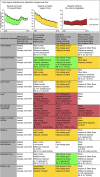Socio-economic and racial/ethnic disparities in the nutritional quality of packaged food purchases in the USA, 2008-2018
- PMID: 33500012
- PMCID: PMC8313635
- DOI: 10.1017/S1368980021000367
Socio-economic and racial/ethnic disparities in the nutritional quality of packaged food purchases in the USA, 2008-2018
Abstract
Objective: To determine whether disparities exist in the nutritional quality of packaged foods and beverage purchases by household income, education and race/ethnicity and if they changed over time.
Design: We used Nielsen Homescan, a nationally representative household panel, from 2008 to 2018 (n = 672 821 household-year observations). Multivariate, multilevel regressions were used to model the association between sociodemographic groups and a set of nutritional outcomes of public health interest, including nutrients of concern (sugar, saturated fat and Na) and calories from specific food groups (fruits, non-starchy vegetables, processed meats, sugar-sweetened beverages and junk foods).
Setting: Household panel survey.
Participants: Approximately 60 000 households each year from the USA.
Results: Disparities were found by income and education for most outcomes and widened for purchases of fruits, vegetables and the percentage of calories from sugar between 2008 and 2018. The magnitude of disparities was largest by education. Disparities between Black and White households include the consumption of processed meats and the percentage of calories from sugar, while no disparities were found between White and Hispanic households. Disparities have been largely persistent, as any significant changes over time have been substantively small.
Conclusions: Policies to improve the healthfulness of packaged foods must be expanded beyond SSB taxes, and future research should focus on what mediates the relationship between education and diet so as not to exacerbate disparities.
Keywords: Diet disparities; Diet quality; Food purchases; Low education.
Figures


 , low income;
, low income;  , middle income;
, middle income;  , high income;
, high income;  , sugar;
, sugar;  , saturated fat
, saturated fat
References
Publication types
MeSH terms
Grants and funding
LinkOut - more resources
Full Text Sources
Other Literature Sources

